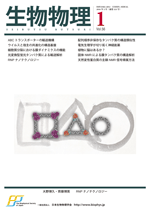All issues

Volume 56, Issue 1
Issue 323
Displaying 1-19 of 19 articles from this issue
- |<
- <
- 1
- >
- >|
Perspective
-
Takashi OGURA2016 Volume 56 Issue 1 Pages 001
Published: 2016
Released on J-STAGE: January 27, 2016
JOURNAL FREE ACCESSDownload PDF (103K)
Review
-
Tadaomi FURUTA, Tomohiro YAMAGUCHI, Hiroaki KATO, Minoru SAKURAI2016 Volume 56 Issue 1 Pages 005-008
Published: 2016
Released on J-STAGE: January 27, 2016
JOURNAL FREE ACCESSATP-binding cassette (ABC) transporters constitute one of the largest superfamilies of membrane proteins that translocate variable substrates through the transmembrane domains (TMDs) powered by the ATP-driven nucleotide-binding domain (NBDs) engines. The coupling helices (CHs) located at the NBD-TMD interfaces play important roles in the structural transition between the inward- and outward-facing conformations. Here, we review our recent studies on the roles of CHs and the effects of ATP and substrates in the functional dynamics of ABC transporters.View full abstractDownload PDF (1111K) -
Etsuko KATOH, Kazuhiro ISHIBASHI2016 Volume 56 Issue 1 Pages 009-012
Published: 2016
Released on J-STAGE: January 27, 2016
JOURNAL FREE ACCESSThe Tm-1 gene of tomato encodes a 754-aa protein that binds tomato mosaic virus (ToMV) replication proteins and inhibits viral RNA replication. We determined a crystal structure of complex of an N-terminal fragment of Tm-1 and helicase domain of ToMV (ToMV-Hel). The residues in ToMV-Hel that are changed in resistance-breaking mutants are directly involved in the interaction. The positively selected region of Tm-1 formed the binding surface with ToMV-Hel. Thus, the antagonistic coevolution between a resistance protein and a viral protein has occurred at the interaction interface on both sides.View full abstractDownload PDF (1018K) -
Tetsuya TAKEDA2016 Volume 56 Issue 1 Pages 013-017
Published: 2016
Released on J-STAGE: January 27, 2016
JOURNAL FREE ACCESSCytokinesis is the final step in cell division essential for cell proliferation, tissue differentiation and animal reproduction. Cytokinesis is featured by its dramatic changes in cell shape by which a cell divides into two nascent cells with equal genomic background. The cell morphogenesis during cytokinesis is mainly driven by extensive reorganization of cytoskeleton. However, recent studies demonstrated that various membrane dynamics such as membrane trafficking and membrane remodeling also play essential roles during cytokinesis. In this review, I will overview function and regulation of the membrane dynamics during cytokinesis and discuss about its future perspectives.View full abstractDownload PDF (833K) -
Spatiotemporal Analysis of Protein Transport and Membrane Morphogenesis in Vertebrate PhotoreceptorsYoshikazu IMANISHI2016 Volume 56 Issue 1 Pages 018-022
Published: 2016
Released on J-STAGE: January 27, 2016
JOURNAL FREE ACCESSThe first step of our vision is initiated when photons are absorbed by the subcellular organelle of photoreceptor neuron called outer segment. Outer segment incorporates phototransduction proteins and structural constituents for its continuous renewal. The author and his colleagues recently developed a photoconversion technique, which allowed monitoring specific protein transport and renewal of outer segment structures. Moreover, quantitative microscopy was harnessed to understand the roles of transport signals in the prototypical ciliary GPCR, rhodopsin. This review summarizes our recent findings on the process of outer segment morphogenesis, membrane protein trafficking and compartmentalization in vertebrate rod photoreceptors.View full abstractDownload PDF (744K) -
Hirohisa OHNO, Hirohide SAITO2016 Volume 56 Issue 1 Pages 023-026
Published: 2016
Released on J-STAGE: January 27, 2016
JOURNAL FREE ACCESSRNA is one of suitable biomaterials for the fabrication in nanoscale, because of its ability to self-assemble. Naturally occurring RNA often interacts with proteins, facilitating and regulating the formation of functional molecular complexes in cells. We focused on RNA-protein complex (RNP) to design and construct synthetic nanostructures, because RNP nanostructures have a potential to form complicated structures with sophisticated functions. Here we review our designed RNP nanostructures and possible biological applications. Functional molecules can be introduced into the RNP nanostructures and applied to control functions of mammalian cells. These RNP nanostructures can expand the field of nanotechnology, biomedicine and synthetic biology.View full abstractDownload PDF (2291K)
Topics
-
Shintaro MINAMI, George CHIKENJI2016 Volume 56 Issue 1 Pages 027-029
Published: 2016
Released on J-STAGE: January 27, 2016
JOURNAL FREE ACCESSDownload PDF (630K) -
Tsuyoshi INOUE, Nagisa SADA2016 Volume 56 Issue 1 Pages 030-032
Published: 2016
Released on J-STAGE: January 27, 2016
JOURNAL FREE ACCESSDownload PDF (372K) -
Motomu ENDO2016 Volume 56 Issue 1 Pages 033-035
Published: 2016
Released on J-STAGE: January 27, 2016
JOURNAL FREE ACCESSDownload PDF (643K)
Theoretical and experimental techniques
-
Izuru KAWAMURA2016 Volume 56 Issue 1 Pages 036-039
Published: 2016
Released on J-STAGE: January 27, 2016
JOURNAL FREE ACCESSDownload PDF (692K) -
Yuichi YOSHIMURA2016 Volume 56 Issue 1 Pages 040-043
Published: 2016
Released on J-STAGE: January 27, 2016
JOURNAL FREE ACCESSDownload PDF (1049K)
Activity of Regional Branch
-
2016 Volume 56 Issue 1 Pages 045-046
Published: 2016
Released on J-STAGE: January 27, 2016
JOURNAL FREE ACCESSDownload PDF (507K)
Young Voice
-
2016 Volume 56 Issue 1 Pages 047-048
Published: 2016
Released on J-STAGE: January 27, 2016
JOURNAL FREE ACCESSDownload PDF (493K)
Letters from Abroad
-
2016 Volume 56 Issue 1 Pages 049-050
Published: 2016
Released on J-STAGE: January 27, 2016
JOURNAL FREE ACCESSDownload PDF (179K)
Promenade along Protein 3D Structures
-
2016 Volume 56 Issue 1 Pages 051
Published: 2016
Released on J-STAGE: January 27, 2016
JOURNAL FREE ACCESSDownload PDF (193K)
Book Review
-
2016 Volume 56 Issue 1 Pages 052
Published: 2016
Released on J-STAGE: January 27, 2016
JOURNAL FREE ACCESSDownload PDF (304K) -
2016 Volume 56 Issue 1 Pages 053
Published: 2016
Released on J-STAGE: January 27, 2016
JOURNAL FREE ACCESSDownload PDF (258K) -
2016 Volume 56 Issue 1 Pages 054
Published: 2016
Released on J-STAGE: January 27, 2016
JOURNAL FREE ACCESSDownload PDF (262K)
Technical term
-
2016 Volume 56 Issue 1 Pages 044
Published: 2016
Released on J-STAGE: January 27, 2016
JOURNAL FREE ACCESSDownload PDF (121K)
- |<
- <
- 1
- >
- >|